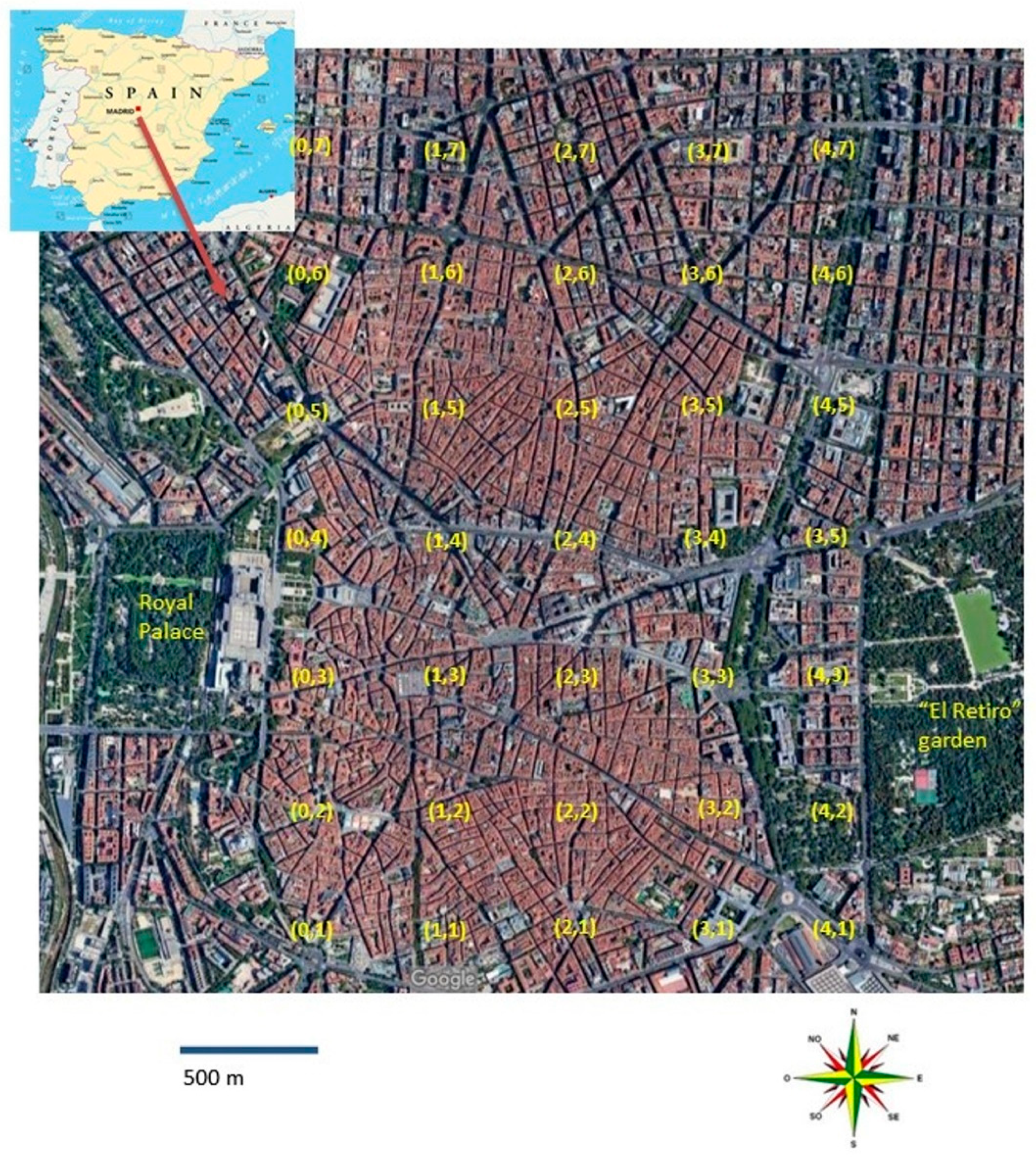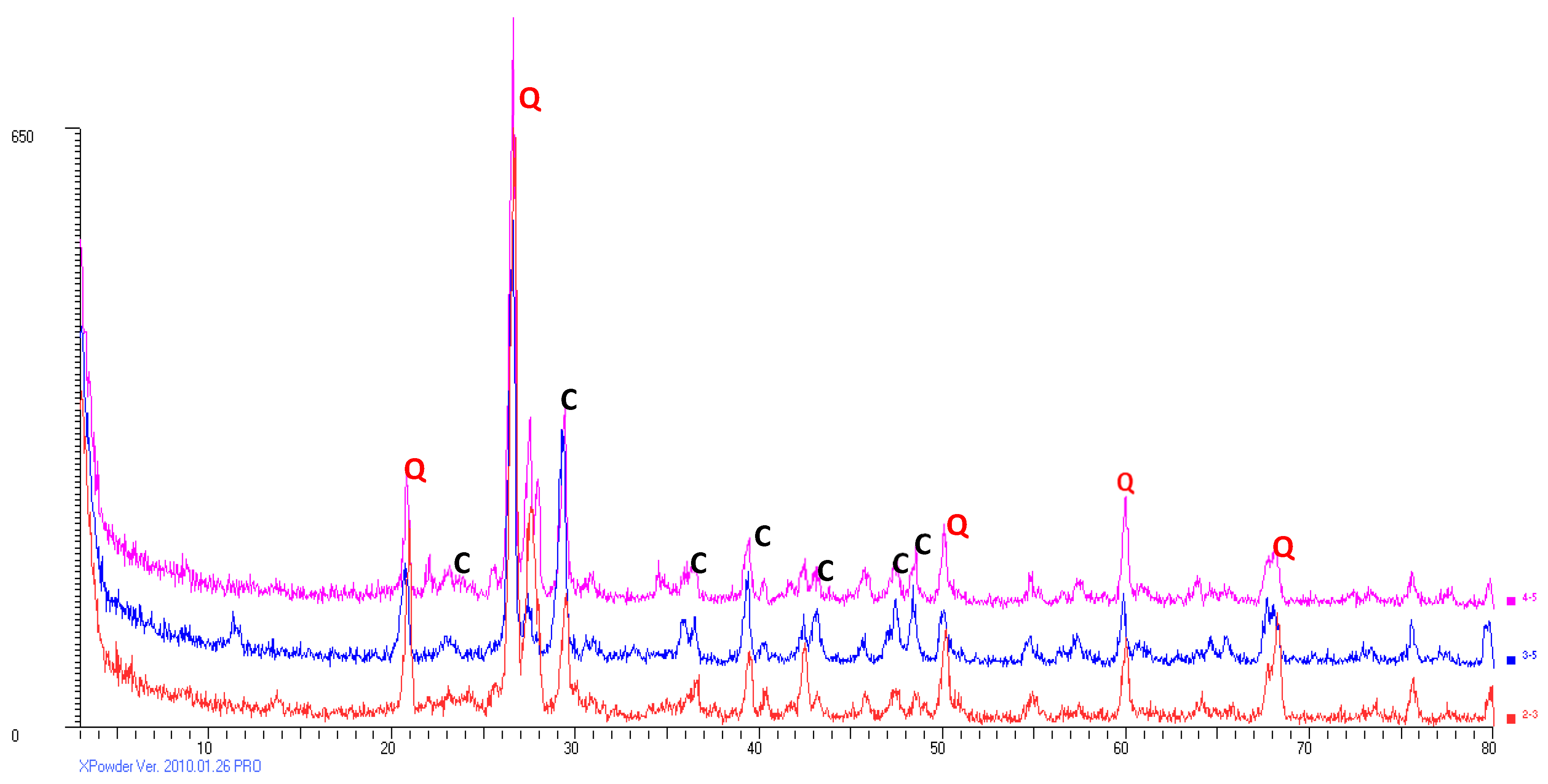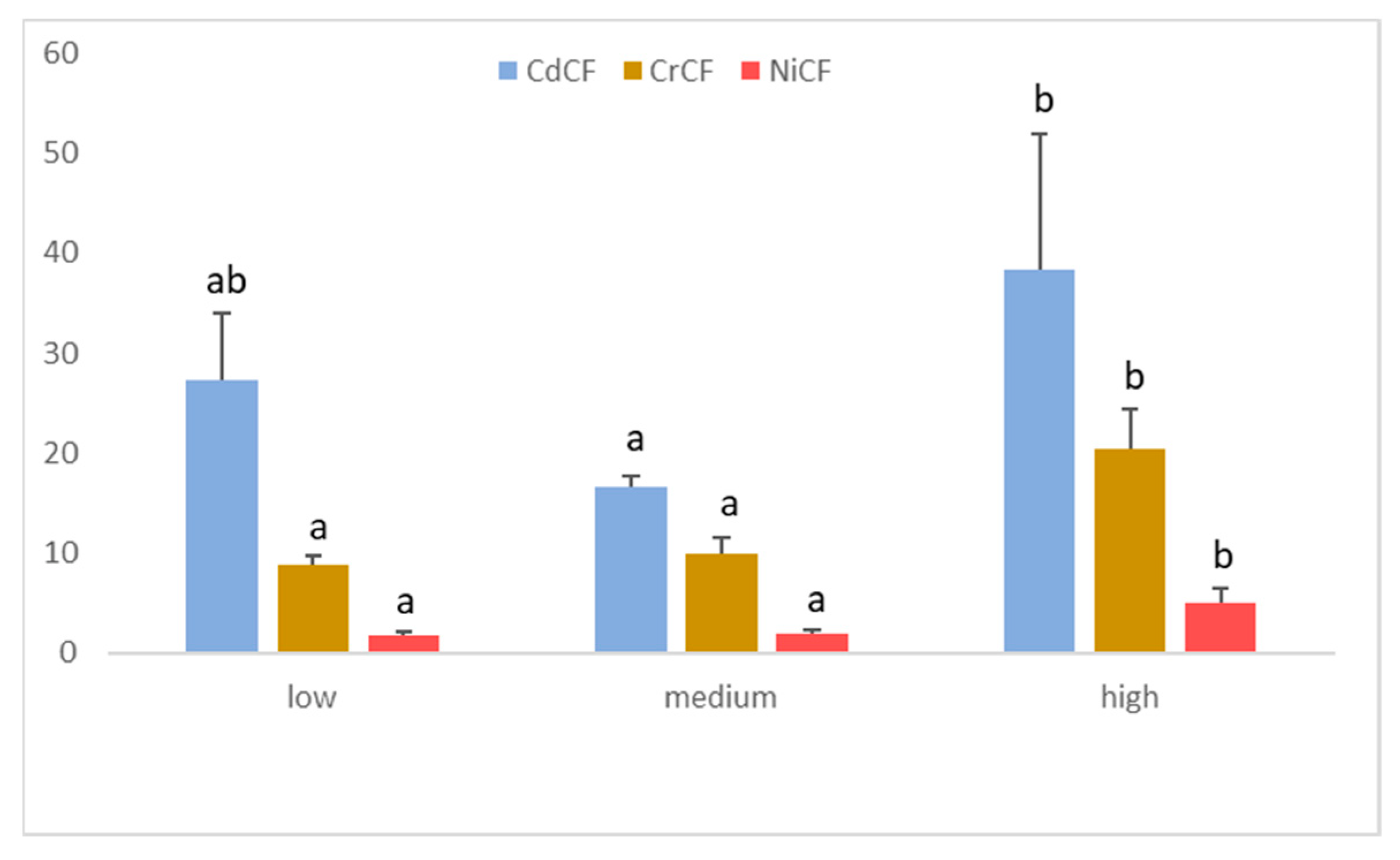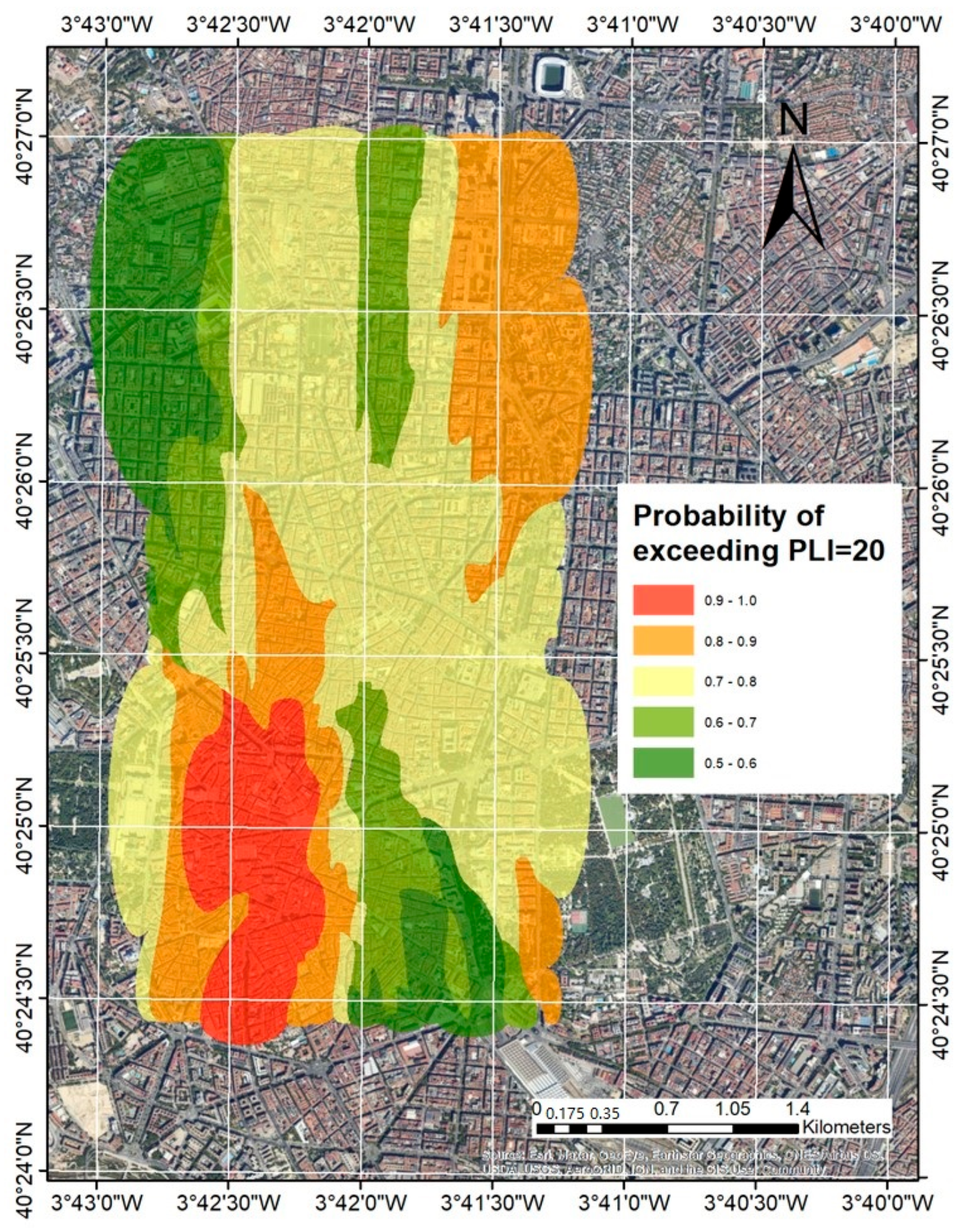Estimation of Ecological and Human Health Risks Posed by Heavy Metals in Street Dust of Madrid City (Spain)
Abstract
:1. Introduction
2. Materials and Methods
2.1. Study Area and Sampling
2.2. Street Dust Analysis Study Area and Sampling
2.3. Environmental Pollution Index and the Potential Risk
2.3.1. Contamination Factor (CF)
2.3.2. Pollution Load Index (PLI)
2.3.3. Enrichment Factor (EF)
2.3.4. Geo-Accumulation Index (Igeo)
2.3.5. Potential Ecological Risk Index (RI)
2.4. Human Health Index and Cancer Risk
2.5. Statistical and Geostatistical Analysis
3. Results and Discussion
3.1. Composition of Street Dust
| City | Populations | Pb | Zn | Cu | Ni | Cr | Cd | PL | Characteristic | Reference |
|---|---|---|---|---|---|---|---|---|---|---|
| Madrid | 6,642,000 | 290 | 895 | 411 | 42 | 100 | 1.25 | 1889 | Present paper | |
| Murcia | 453,238 | 137 229 163 | 673 618 693 | 157 234 271 | 35 76 31 | 80 169 93 | - | 1082 1326 1251 | Low Medium High traffic | [47] |
| Madrid | 3,000,000 | 1927 | 476 | 188 | 44 | 61 | - | 2696 | [26] | |
| Estambul | 12,000,000 | 212 | 520 | 208 | 33 | - | 2.3 | 973 * | [25] | |
| Islamabad | 800,000 | 104 | 116 | 52 | 23 | - | - | 295 * | [24] | |
| Dakha | 140,921,000 | 74 | 154 | 46 | 26 | - | - | 300 * | [23] | |
| Mexico City | 20,000,000 | 116 | 447 | 93 | 45 | 93 | - | 794 | Top urban soil | [22] |
| Oslo | 1,762,000 | 180 | 412 | 123 | 41 | - | 1.4 | 756 * | [26] | |
| París | 2,137,000 | 1450 | 840 | 1075 | 25 | - | - | 3390 * | Highway | [49] |
| Monterrey | 1,142,952 | 227 | 649 | 167 | - | 102 | - | - | [48] | |
| Teheran | 12,183,391 | 56 | 46 | 74 | - | - | - | - | Commercial use | [51] |
| background (asphalt) | 22 | 61 | 14 | 11 | 13 | - | 121 | Present paper |
3.2. Environmental Pollution Index
3.3. Influence of Color and Density of Traffic
3.4. Human Health Index and Cancer Risk
4. Conclusions
Supplementary Materials
Author Contributions
Funding
Institutional Review Board Statement
Conflicts of Interest
References
- Ahmadipour, F.; Bahramifar, N.; Ghasempouri, S.M. Fractionation and mobility of cadmium and lead in soils of Amol area in Iran, using the modified BCR sequential extraction method. Chem. Speciat. Bioavailab. 2014, 26, 31–36. [Google Scholar] [CrossRef]
- Wei, B.; Yang, L. A review of heavy metal contaminations in urban soils, urban road dusts and agricultural soils from China. Microchem. J. 2010, 94, 99–107. [Google Scholar] [CrossRef]
- Zibret, G.; Van Tonder, D.; Zibret, L. Metal content in street dust as a reflection of atmospheric dust emissions from coal power plants, metal smelters, and traffic. Environ. Sci. Pollut. Res. Int. 2013, 20, 4455–4468. [Google Scholar] [CrossRef] [PubMed]
- Trujillo-González, J.M.; Torres-Mora, M.; Keesstra, S.; Brevik, E.C.; Jimenez-Ballesta, R. Heavy metal accumulation related to population density in road dust samples taken from urban sites under different land uses. Sci. Total Environ. 2016, 553, 636–642. [Google Scholar] [CrossRef]
- Li, Y.; Yu, Y.; Yang, Z.; Shen, Z.; Wang, X.; Cai, Y. A comparison of metal distribution in surface dust and soil among super city, town and rural area. Environ. Sci. Pollut. Res. Int. 2016, 23, 7849–7860. [Google Scholar] [CrossRef]
- Duong, T.T.; Lee, B.K. Determining contamination level of heavy metals in road dust from busy traffic areas with different characteristics. J. Environ. Manag. 2011, 92, 554–562. [Google Scholar] [CrossRef]
- De Miguel, E.; Irribaren, I.; Chacón, E.; Ordoñez, A.; Charlesworth, S. Risk-based evaluation of the exposure of children to trace elements in playgrounds in Madrid (Spain). Chemosphere 2007, 66, 505–513. [Google Scholar] [CrossRef]
- Acosta, J.A.; Faz Cano, A.; Arocena, J.M.; Debela, F.; Martínez-Martínez, S. Distribution of metals in soil particle size fractions and its implication to risk assessment of playgrounds in Murcia City (Spain). Geoderma 2009, 149, 101–109. [Google Scholar] [CrossRef]
- Mangani, G.; Berloni, A.; Bellucci, F.; Tatano, F.; Maione, M. Evaluation of the pollutant content in road runoff first flush waters. Water Air Soil Pollut. 2005, 160, 213–228. [Google Scholar] [CrossRef]
- Dheeraj, A.V.; Kuppili, S.K.; Nagendra, S.M.S.; Ramadurai, G.; Sethi, V.; Kumar, R.; Sharma, N.; Namdeo, A.; Bell, M.; Goodman, P.; et al. Characteristics of tail pipe (nitric oxide) and resuspended dust emissions from urban roads—A case study in Delhi city. J. Transp. Health 2020, 17, 100653. [Google Scholar] [CrossRef]
- Wilson, W.E.; Suh, H.H. Fine particles and coarse particles: Concentration relationships relevant to epidemiologic studies. J. Air Waste Manag. Assoc. 1997, 47, 1238–1242. [Google Scholar] [CrossRef] [Green Version]
- Duruibe, J.O.; Ogwuegbu, M.O.C.; Egwurugwu, J.N. Heavy metal pollution and human biotoxic effects. Int. J. Phys. Sci. 2007, 2, 112–118. [Google Scholar]
- Sabath, D.E.; Osorio, L.R. Medio ambiente y riñón: Nefrotoxicidad por metales pesados. Nefrología 2012, 32, 279–286. [Google Scholar] [CrossRef]
- World Health Organization. Review of Evidence on Health Aspects of Air Pollution-REVIHAAP; First Results; WHO Regional Office for Europe: Copenhagen, Denmark, 2013. [Google Scholar]
- Valko, M.; Rhodes, C.J.; Moncol, J.; Izakovic, M.; Mazur, M. Free radicals, metals and antioxidants in oxidative stress-induced cancer. Chem. Biol. Interact. 2006, 160, 1–40. [Google Scholar] [CrossRef]
- Ouchir, N.; Ben Aissa, L.B.; Boughdiri, M.; Aydi, A. Assessment of heavy metal contamination status in sediments and identification of pollution source in Ichkeul Lake and rivers ecosystem, northern Tunisia. Arab. J. Geosci. 2016, 9, 539. [Google Scholar] [CrossRef]
- Chandrasekaran, A.; Mukesh, M.V.; Chidambaram, S.; Singarasubramanian, S.R.; Rajendran, S.; Muthukumarasamy, R.; Tamilselvi, M. Assessment of heavy metal distribution pattern in the sediments of Tamirabanari river and estuary, east coast of Tamil Nadu, India. Environ. Earth Sci. 2014, 73, 2441–2452. [Google Scholar] [CrossRef]
- Tomlinson, D.L.; Wilson, J.G.; Harris, C.R.; Jeffrey, D.W. Problems in the assessment of heavy metal levels in estuaries and the formation of a pollution index. Helgol. Meeresunter 1980, 33, 566–575. [Google Scholar] [CrossRef] [Green Version]
- Müller, G. Index of Geoaccumulation in sediments of the Rhine River. Geojournal 1969, 2, 108–118. [Google Scholar]
- Liu, E.; Yan, T.; Birch, G.; Zhu, Y. Pollution and health risk of potentially toxic metals in urban road dust in Nanjing, a mega-city of China. Sci. Total Environ. 2014, 476–477, 522–531. [Google Scholar] [CrossRef]
- Ihl, T.; Bautista, F.; Cejudo, R.; Delgado, C.; Quintana, P.; Aguilar, D.; Goguitchaichvili, A. Concentration of toxic elements in topsoils of the metropolitan area of México City: A spatial analysis using ordinary Kriging and indicator Kriging. Rev. Int. Contam. Ambie. 2015, 31, 47–62. [Google Scholar]
- Rodríguez-Salazar, M.T.; Morton-Bermea, O.; Hernández-Álvarez, E.; Lozano, R.; Tapia-Cruz, V. The study of metal contamination in urban topsoils of Mexico City using GIS. Environ. Earth Sci. 2011, 62, 899–905. [Google Scholar] [CrossRef]
- Ahmed, F.; Ishiga, H. Trace metal concentrations in street dust of Dhaka city, Bangladesh. Atmos. Environ. 2006, 40, 3835–3844. [Google Scholar] [CrossRef]
- Faiz, Y.; Tufail, M.; Tayyeb Javed, M.; Chaundry, M.M.; Naila-Siddique. Road dust pollution of Cd, Cu, Ni, Pb and Zn along Islamabad Expressway, Pakistan. Microchem. J. 2009, 92, 186–192. [Google Scholar] [CrossRef]
- Segzin, N.; Kurtulus, H.; Demir, G.; Nemlioglu, S.; Bayat, C. Determination of heavy metal concentrations in street dusts in Istanbul. E-5 highway. Environ. Int. 2003, 29, 979–985. [Google Scholar] [CrossRef]
- De Miguel, E.; Llamas, J.F.; Chacon, E.; Berg, T.; Larssen, S.; Royset, O.; Vadest, M. Origin and patterns of distribution of trace elements in street dust: Unleaded petrol and urban lead. Atmos. Environ. 1997, 31, 2733–2740. [Google Scholar] [CrossRef]
- Khomenko, S.; Cirach, M.; Pereira-Barboza, E.; Mueller, N.; Barrera-Gómez, J.; Rojas-Rueda, D.; de Hoogh, K.; Hoek, G.; Nieuwenhuijsen, M. Premature mortality due to air pollution in European cities; an Urban Burden of Disease Assessment. Lancet Planet. Health 2021, 5, e121–e134. [Google Scholar] [CrossRef]
- Salas, R.; Perez-Villadoniga, M.J.; Prieto-Rodriguez, J.; Russo, A. Were traffic restrictions in Madrid effective at reducing NO2 levels? Transp. Res. D-Transp. Environ. 2021, 91, 102689. [Google Scholar] [CrossRef]
- Patiño, M.T.; Ballesta, R.; Rivero, V.; García, R. Diferenciación textural en suelos de la cuenca de Madrid. Alteración y génesis mineral. Bol. Geol. Min. 1990, 101, 94–107. [Google Scholar]
- USEPA. AP-42, Appendix C.1. Procedures for Sampling Surface/Bulk Dust Loading, 5th ed.; US Environmental Protection Agency: Washington, DC, USA, 2003. [Google Scholar]
- USEPA. AP-42, Appendix C.2. Procedures for Laboratory Analysis of Surface/Bulk Dust Loading Samples, 5th ed.; US Environmental Protection Agency: Washington, DC, USA, 2003. [Google Scholar]
- Munsell Color. Munsell Soil Color Charts; Revised Washable Edition; Gretag Macbeth: Grand Rapids, MI, USA, 2000. [Google Scholar]
- Ure, A.M.; Quevauviller, P.H.; Muntau, H.; Griepink, B. Speciation of heavy metals in soils and sediments. An account of the improvement and harmonization of extraction techniques undertaken under the auspices of the BCR of the Commission of the European Communities. Int. J. Anal. Chem. 1993, 51, 135–151. [Google Scholar] [CrossRef]
- Chester, R.; Stoner, J.H. Pb in particulates from the lower atmosphere of the eastern Atlantic. Nature 1973, 245, 27–28. [Google Scholar] [CrossRef]
- Zoller, W.H.; Gladney, E.S.; Duce, R.A. Atmospheric concentrations and sources of trace metals at the South Pole. Science 1974, 183, 198–200. [Google Scholar] [CrossRef]
- Sutherland, R.A. Bed sediment-associated trace metals in an urban stream, Oahu, Hawaii. Environ. Geol. 2000, 36, 611–627. [Google Scholar] [CrossRef]
- Häkanson, L. An ecological risk index for aquatic pollution control. A sedimentological approach. Water Res. 1980, 14, 975–1001. [Google Scholar] [CrossRef]
- USEPA, United States Environmental Protection Agency (US EPA). Risk Assessment Guidance for Superfund. Human Health Evaluation Manual (Part A); EPA/540/1-89/002; Office of Solid Waste and Emergency Response: Washington, DC, USA, 1989; Volume I. [Google Scholar]
- USEPA, United States Environmental Protection Agency (US EPA). Soil Screening Guidance Technical Background Document; EPA/540/R95; Office of Solid Waste and Emergency Response: Washington, DC, USA, 1996. [Google Scholar]
- Van den Berg, R. Human Exposure to Soil Contamination: A Qualitative and Quantitative Analysis Towards Proposals for Human Toxicological Intervention Values; RIVM Repport. 725201011; National Institute for Public Health and the Environment: Bilthoven, The Netherlands, 1994. [Google Scholar]
- Ferreira-Baptista, L.; De Miguel, E. Geochemistry and risk assessment of street dust in Luanda, Angola: A tropical urban environment. Atmos. Environ. 2005, 39, 4501–4512. [Google Scholar] [CrossRef] [Green Version]
- USEPA, United States Environmental Protection Agency (US EPA). Supplemental Guidance for Developing Soil Screening Levels for Superfund Sites; OSWER Directive; Office of the Solid Waste and Emergency Response: Washington, DC, USA, 2001; Volume 9355, pp. 4–24. [Google Scholar]
- Zheng, N.; Liu, J.; Wang, Q.; Liang, Z. Health risk assessment of heavy metal exposure to street dust in the zinc smelting district, Northeast of China. Sci. Total Environ. 2010, 408, 726–733. [Google Scholar] [CrossRef]
- Zhang, M.; Li, X.; Yang, R.; Wang, J.; Ai, Y.; Gao, Y.; Zhang, Y.; Zhang, X.; Yan, X.; Liu, B.; et al. Multipotential toxic metals accumulated in urban soil and street dust form Xining City, NW China: Spatial occurrences, sources, and health risks. Arch. Environ. Contam. Toxicol. 2019, 76, 308–330. [Google Scholar] [CrossRef]
- Banat, K.M.; Howari, F.M.; Al-Hamad, A.A. Heavy metals in urban soils of central Jordan: Should we worry about their environmental risks? Environ. Res. 2005, 97, 258–273. [Google Scholar] [CrossRef]
- Kabadayi, F.; Cesur, H. Determination of Cu, Pb, Zn, Ni, Co, Cd and Mn in roads dusts of Samsun City. Environ. Monit. Assess. 2010, 168, 241–253. [Google Scholar] [CrossRef]
- Marín Sanleandro, P.; Sánchez Navarro, A.; Díaz-Pereira, E.; Bautista Zúñiga, F.; Romero Muñoz, M.; Delgado Iniesta, M.J. Assessment of heavy metals and color as indicators of contamination in street dust of a city in SE Spain: Influence of traffic intensity and sampling location. Sustainability 2018, 10, 4105. [Google Scholar] [CrossRef] [Green Version]
- Urrutia-Goyes, R.; Hernández, N.; Carrillo-Gamboa, O.; Nigam, K.D.P.; Ornelas-Soto, N. Street dust from a heavily-populated and industrialized city: Evaluation of spatial distribution, origins, pollution, ecological risks and human health repercussions. Ecotoxicol. Environ. Saf. 2018, 159, 198–204. [Google Scholar] [CrossRef]
- Pagotto, C.; Remy, N.; Legret, M.; Le Cloirec, P. Heavy metal pollution of road dust and roadside soil near a major rural highway. Environ. Technol. 2001, 22, 307–319. [Google Scholar] [CrossRef] [PubMed]
- Querol, X. Calidad del aire, partículas en suspensión y metales. Rev. Esp. Salud Pública 2008, 82, 447–454. [Google Scholar] [CrossRef] [PubMed] [Green Version]
- Mihankhah, T.; Saeedi, M.; Karbassi, A. A comparative study of elemental pollution and health risk assessment in urban dust of different land-uses in Tehran's urban area. Chemosphere 2020, 241, 124984. [Google Scholar] [CrossRef]
- Baize, D. Teneurs Totales en Éléments Traces Métalliques dans les Sols (Francia): Références et Stratégies d'Interprétation; INRA Edètion: Paris, France, 1997; p. 410. [Google Scholar]
- Adriano, D.C.; Chlopecka, A. Soil contamination and remediation: Philosophy, science and technology. In Proceedings of the International Conference on the Biogeochemistry of Trace Elements, Paris, France, 15–19 May 1995. [Google Scholar]
- Nemati, K.; Bakar, N.K.A.; Abas, M.R.; Sobhanzadeh, E. Speciation of heavy metals by modified BCR sequential extraction procedure in different depths of sediments from Sungai Buloh, Selangor, Malaysia. J. Hazard. Mater. 2011, 192, 402–410. [Google Scholar] [CrossRef]
- Li, H.; Qian, X.; Hu, W.; Wang, Y.; Gao, H. Chemical speciation and human health risk of trace metals in urban street dusts from a metropolitan city, Nanjing, SE China. Sci. Total Environ. 2013, 456, 212–221. [Google Scholar] [CrossRef]
- Aguilera, A.; Bautista, F.; Gutiérrez-Ruiz, M.; Ceniceros-Gómez, A.E.; Cejudo, R.; Goguitchaichvili, A. Heavy metal pollution of street dust in the largest city of Mexico, sources and health risk assessment. Environ. Monit. Assess. 2021, 193, 193. [Google Scholar] [CrossRef]
- Jiang, Y.; Shi, L.; Guang, A.L.; Mu, Z.; Zhan, H.; Wu, Y. Contamination levels and human health risk assessment of toxic heavy metals in street dust in an industrial city in Northwest China. Environ. Geochem. Health 2018, 40, 2007–2020. [Google Scholar] [CrossRef]
- Aguilar, Y.; Bautista, F.; Quintana, P.; Aguilar, D.; Trejo-Tzab, R.; Goguitchaichvili, A.; Chan-Te, R. Color as a New Proxy Technique for the Identification of Road Dust Samples Contaminated with Potentially Toxic Elements: The Case of Mérida, Yucatán, México. Atmosphere 2021, 12, 483. [Google Scholar] [CrossRef]
- Jadoon, W.A.; Khpalwak, W.; Chidya, R.; Abdel-Dayem, S.M.M.A.; Takeda, K.; Arshad, M.; Sakugawa, H. Evaluation of Levels, Sources and Health Hazards of Road-Dust Associated Toxic Metals in Jalalabad and Kabul Cities, Afghanistan. Arch. Environ. Contam. Toxicol. 2018, 74, 32–45. [Google Scholar] [CrossRef]
- Lanphear, B.P.; Burgoon, D.A.; Rust, S.W.; Eberly, S.; Galke, W. Environmental exposure to lead and urban children’s blood lead level. Environ. Res. 1998, 76, 120–130. [Google Scholar] [CrossRef]
- Wu, S.; Peng, X.; Zhang, D.; Wu, W.; Luo, T.; Zhang, S.; Zhou, G.; Yang, H.; Wan, L.; Wu, J. Levels and health risk assessments of heavy metals in urban soils in Dongguan, China. Geochem. Explor. 2015, 148, 71–78. [Google Scholar] [CrossRef]
- Men, C.; Liu, R.; Xu, F.; Wang, Q.; Guo, L.; Shen, Z. Pollution characteristics, risk assessment, and source apportionment of heavy metals in road dust in Beijing, China. Sci. Total Environ. 2018, 612, 138–147. [Google Scholar] [CrossRef] [PubMed]





| Cd | Cr | Cu | Ni | Pb | Zn | |
|---|---|---|---|---|---|---|
| RfDing | 1.00E-03 | 3.00E-03 | 4.00E-0.2 | 2.00E-02 | 3.50E-03 | 3.00E-0.1 |
| RfDder | 1.00E-05 | 6.00E-05 | 1.20E-02 | 5.40E-03 | 5.25E-04 | 6.00E-02 |
| RfDinh | 1.00E-03 | 2.86E-05 | 4.02E-02 | 2.06E-02 | 3.52E-03 | 3.00E-01 |
| SF | 6.30E+00 | 4.20E+01 | 8.40E-01 | 4.20E-02 |
| Index | Cd | Cr | Cu | Ni | Pb | Zn |
|---|---|---|---|---|---|---|
| CF | 24.9 | 11.6 | 12.9 | 2.5 | 89.0 | 30.5 |
| EF | 43.5 | 19.1 | 21.9 | 4.2 | 157.2 | 53.0 |
| Igeo | 3.8 | 2.7 | 2.7 | 0.4 | 5.6 | 4.0 |
| Children | |||||||
|---|---|---|---|---|---|---|---|
| Element | Ding | Dinh | Dderm | HQing | HQinh | HQderm | HI |
| Cd | 1.6E-05 | 4.5E-10 | 2.5E-08 | 1.6E-02 | 4.5E-07 | 4.5E-05 | 1.6E-02 |
| Cr | 1.3E-03 | 3.6E-08 | 2.1E-06 | 4.3E-01 | 1.3E-03 | 6.0E-04 | 4.3E-01 |
| Cu | 5.3E-03 | 1.5E-07 | 8.4E-06 | 1.3E-01 | 3.7E-06 | 1.2E-05 | 1.3E-01 |
| Ni | 5.3E-04 | 1.5E-08 | 8.6E-07 | 2.7E-02 | 7.3E-07 | 2.8E-06 | 2.7E-02 |
| Pb | 5.6E-03 | 1.6E-07 | 9.0E-06 | 1.6E+00 | 4.5E-05 | 3.0E-04 | 1.1E+00 |
| Zn | 1.1E-02 | 3.2E-07 | 1.8E-05 | 3.8E-02 | 1.1E-06 | 5.4E-06 | 3.8E-02 |
| Adults | |||||||
| Element | Ding | Dinh | Dderm | HQing | HQinh | HQderm | HI |
| Cd | 1.7E-06 | 1.6E-10 | 5.2E-09 | 1.7E-03 | 4.5E-07 | 4.5E-05 | 1.8E-03 |
| Cr | 1.4E-04 | 1.3E-08 | 4.2E-07 | 4.6E-02 | 1.3E-03 | 6.0E-04 | 4.8E-02 |
| Cu | 5.6E-04 | 5.3E-08 | 1.7E-06 | 1.4E-02 | 3.7E-06 | 1.2E-05 | 1.4E-02 |
| Ni | 5.7E-05 | 5.4E-09 | 1.7E-07 | 2.9E-03 | 7.3E-07 | 2.8E-06 | 2.9E-03 |
| Pb | 6.0E-04 | 5.7E-08 | 1.8E-06 | 1.7E-01 | 4.5E-05 | 3.0E-04 | 1.1E-01 |
| Zn | 1.2E-03 | 1.2E-07 | 3.7E-06 | 4.1E-03 | 1.1E-06 | 5.4E-06 | 4.1E-03 |
| CdLADD | CrLADD | CuLADD | NiLADD | PbLADD | CdCR | CrCR | NiCR | PbCR |
|---|---|---|---|---|---|---|---|---|
| 9.3E-11 | 7.5E-09 | 3.1E-08 | 3.1E-09 | 3.3E-08 | 5.9E-10 | 3.2E-07 | 2.6E-09 | 1.4E-09 |
Publisher’s Note: MDPI stays neutral with regard to jurisdictional claims in published maps and institutional affiliations. |
© 2022 by the authors. Licensee MDPI, Basel, Switzerland. This article is an open access article distributed under the terms and conditions of the Creative Commons Attribution (CC BY) license (https://creativecommons.org/licenses/by/4.0/).
Share and Cite
Delgado-Iniesta, M.J.; Marín-Sanleandro, P.; Díaz-Pereira, E.; Bautista, F.; Romero-Muñoz, M.; Sánchez-Navarro, A. Estimation of Ecological and Human Health Risks Posed by Heavy Metals in Street Dust of Madrid City (Spain). Int. J. Environ. Res. Public Health 2022, 19, 5263. https://doi.org/10.3390/ijerph19095263
Delgado-Iniesta MJ, Marín-Sanleandro P, Díaz-Pereira E, Bautista F, Romero-Muñoz M, Sánchez-Navarro A. Estimation of Ecological and Human Health Risks Posed by Heavy Metals in Street Dust of Madrid City (Spain). International Journal of Environmental Research and Public Health. 2022; 19(9):5263. https://doi.org/10.3390/ijerph19095263
Chicago/Turabian StyleDelgado-Iniesta, María José, Pura Marín-Sanleandro, Elvira Díaz-Pereira, Francisco Bautista, Miriam Romero-Muñoz, and Antonio Sánchez-Navarro. 2022. "Estimation of Ecological and Human Health Risks Posed by Heavy Metals in Street Dust of Madrid City (Spain)" International Journal of Environmental Research and Public Health 19, no. 9: 5263. https://doi.org/10.3390/ijerph19095263






